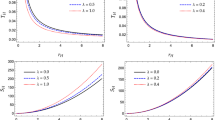Abstract
We propose a model of our universe as a 3-sphere resting on the surface of a black hole which exists in a spacetime consisting of four space dimensions and one time dimension. The matter and energy within our universe exist as stationary solutions to the field equations in the Rindler coordinates just above the horizon of the black hole. Each solution may be though of as a standing wave consisting of a wave propagating toward the horizon superposed with its time-reversed twin propagating away from the horizon. As matter and energy from the greater five-dimensional spacetime fall into the black hole, its radius increases and our universe expands. This mechanism of expansion allows the model to describe a universe which is older than its oldest stars and homogeneous without inflation. It also predicts galaxy counts at high redshift which agree with observation.
Similar content being viewed by others
References
Demarque, P., Deliyannis, C. P., and Sarajedini, A. (1991). InObservational Tests of Cosmological Inflation, T. Shankset al., ed., Kluwer, Dordrecht, p. 111.
Einstein, A., and de Sitter, W. (1932).Proceedings of the National Academy of Science USA,18, 213.
Guth, A. (1981).Physical Review D,23, 347.
Higgs, P. (1964).Physics Letters,12, 132.
Kennicutt, R. C., Jr., Freedman, W. L., and Mould, J. R. (1995).Astronomical Journal,110(4), 1476.
Lilly, S. J., Cowie, L. L., and Gardner, J. P. (1991).Astrophysical Journal,369, 79.
McFarland, B. (1997).International Journal of Theoretical Physics,36, 743–755.
Peebles, P. J. E. (1993).Principles of Physical Cosmology, Princeton University Press, Princeton, New Jersey, p. 675.
Author information
Authors and Affiliations
Rights and permissions
About this article
Cite this article
McFarland, B. New cosmology. Int J Theor Phys 36, 1423–1433 (1997). https://doi.org/10.1007/BF02435936
Received:
Issue Date:
DOI: https://doi.org/10.1007/BF02435936




